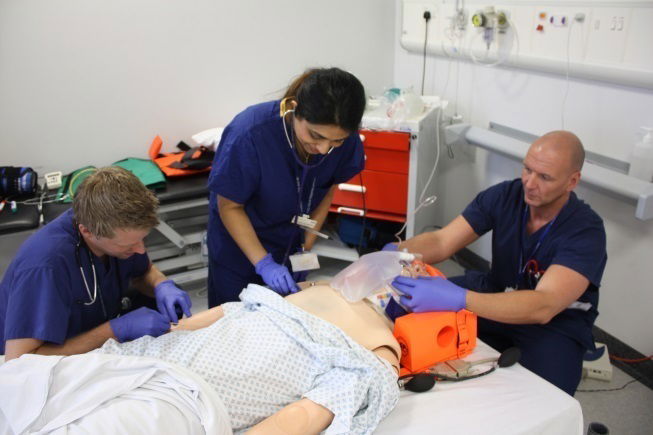Advanced Trauma Life Support

Pre -hospital stage
prepare resources and personnel
Set the role of every participant
Triage
Triage is a french word mean to sort
according to RPM
R:respiratory rate less than 4 or more than 20
P: abscence of radial pulses
M:Mobility
Black or dead : no sign of life
Red : life threatening condition
Yellow : immobile
Green : mobile patient with minor injury
Primary survey and resuscitation (ABCDE)
A: Maintain adequate airway + cervical spine support
Talk to the patient if not speak means there is problem in airway
The cervical spine should be supported by
a. Cervical collar
b. Two sand bags with fore head tapes or
c. In line traction (the head supported by person)
Then start suction, remove the vomitus and F.B
Then chin lift and jaw thrust → to prevent the tongue from falling back
Then insert pharyngeal airway (oral or nasal pharyngeal airway ) → to
prevent the tongue from falling back
Then intubation if no response → if the above measures failed
Then emergency cricothyroidotomy
Then emergency tracheostomy → the definitive treatment of airway
obstruction
B: Maintain adequate breathing + ventilation
Assess breathing by exposing the chest and neck for
Look
Chest movement (rate and depth of breathing)
Open wound in the chest
Bulging of the chest
Distended neck veins
Subcutaneous emphysema
Feel
Trachea deviated or not
The chest dull or hyperresonance
Crepitus
Listen
↓ Air entry
Muffled heart sound
C: Maintain circulation and control haemorrhage
Assess for sign of haemodynamic instability by
Puls /BP/RR
Capillary refill
Temperature of the exterimities
Urine out put
Mental status
Look for external bleeding and controlled by pressure and bandaging
Identify the source of internal bleeding
Management
Insert 2 wide bore cannulae and take blood for blood grouping and crossmatching
Hb, RBG, RFT with electrolytes
Give 2 L of Normal saline or Ringer Lactate in half hour
Control external bleeding by pressure and bandaging
D: Assessment of CNS dysfunction
Initial assessment of CNS dysfunction by
A= Alert
V = Reponse to voice
P = Response to pain
U = Unresponsive
Assess the pupil for ( normal/dilated/constricted/react to light or not)
E:Exposure with environment control
Adjuvant to primary survey
It include: completion of resuscitation
Pulse oxymetry for vital signs monitoring
chest ,lateral cervical and pelvic x-ray if portable
urinary catheter after exclusion of urtheral injuries
NG tube if needed (after exclusion of fracture base of the skull)
Secondary survey
A.History
A: Allergies
M:Medications
P: Past medical history and pregnancy
L:Last Meal
E:Events leading to trauma
B.Examination
Examination of the whole body from head to toes
scalp: scalp laceration and haematoma
Eyes: conjectival haemorrhage - Raccoon eyes
Pupil: dilation and symmetry
Nose and ear: injuries + CSF or blood from the nose or the ear
Chest and CVS: for abnormalities
Abdomen: distension,tenderness,bowel sounds.
Urthera:bleeding +scrotal or perineal swelling
Upper and lower extermities: for tenderness and deformity
Back: using log rolling technique for deformity and tenderness



